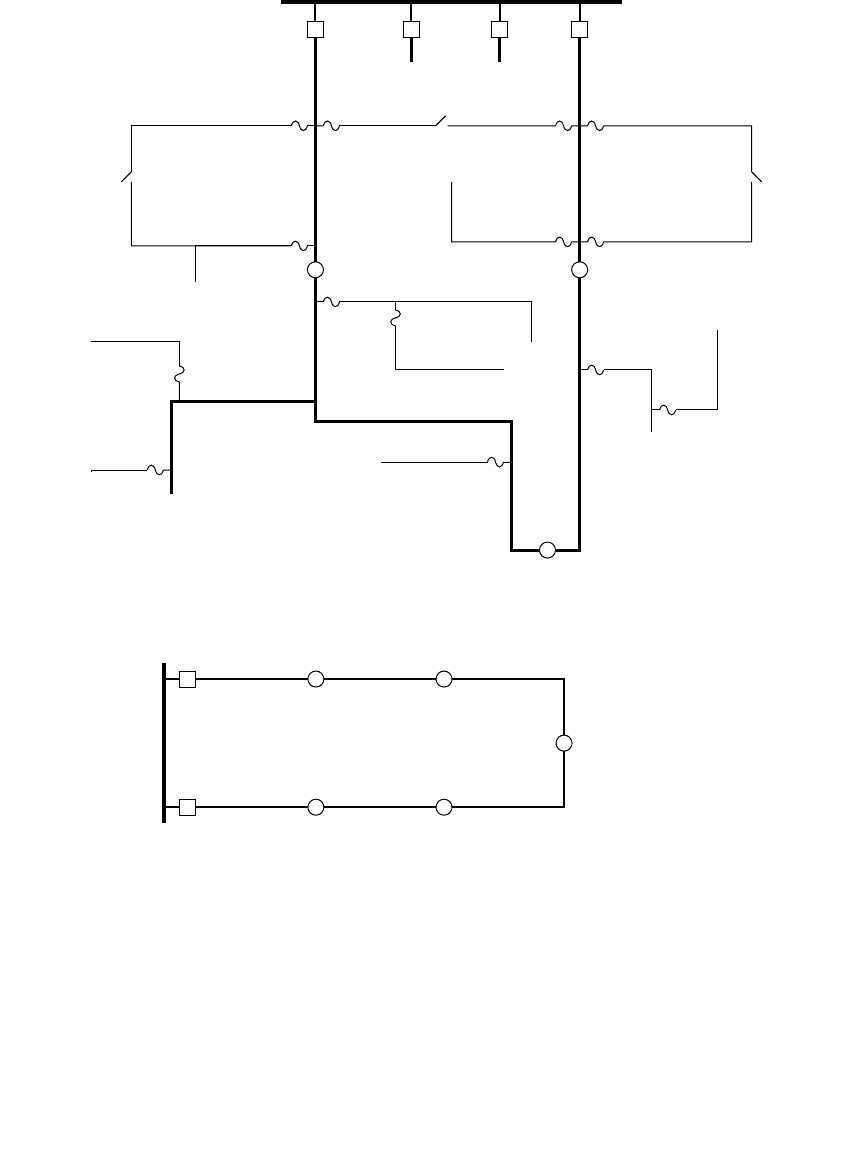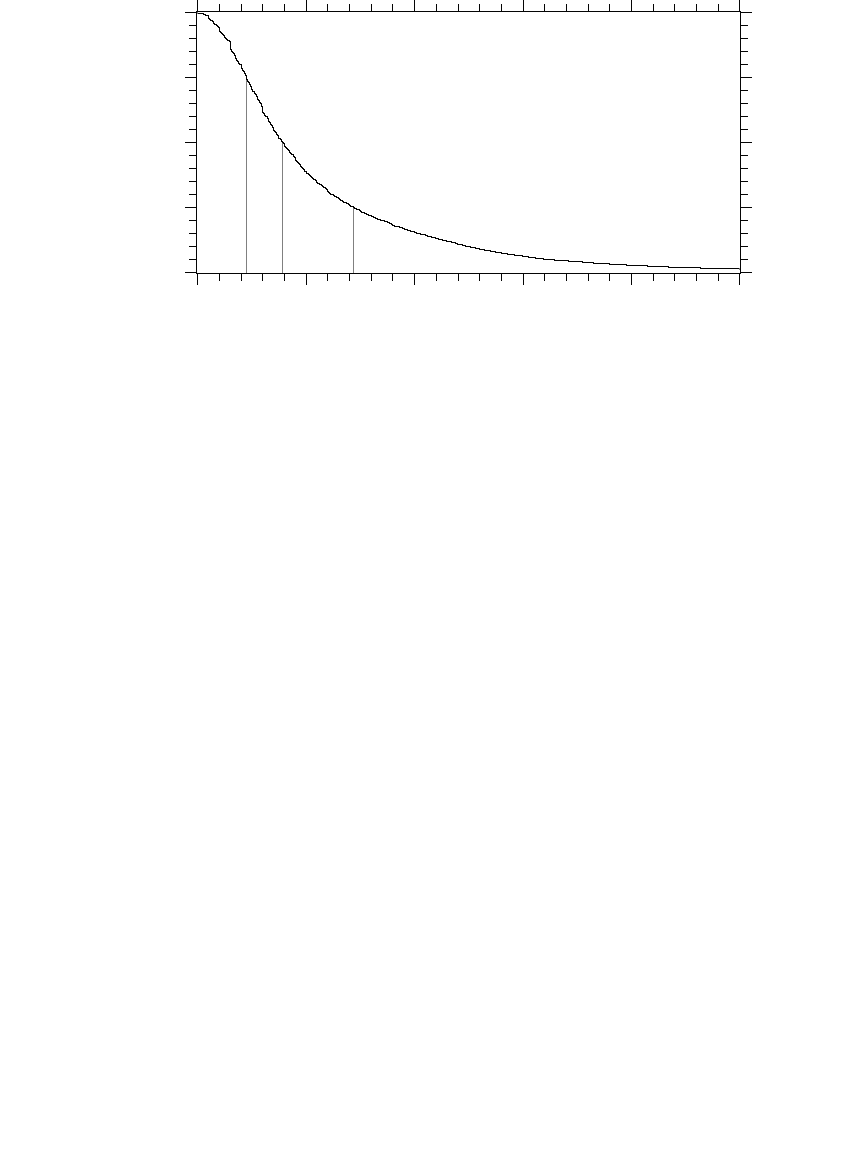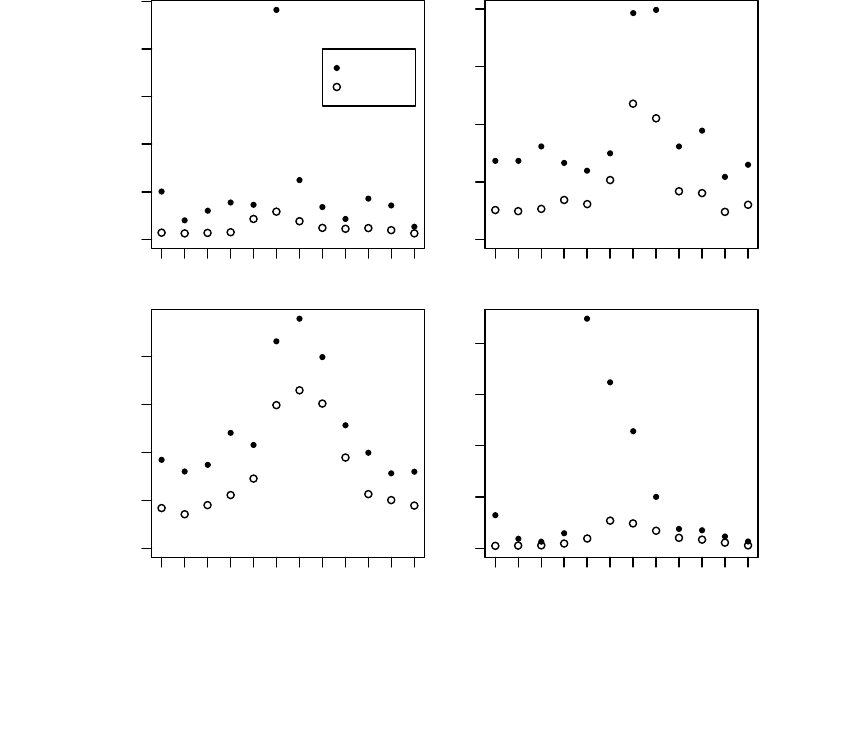Short T.A. Electric Power Distribution Handbook
Подождите немного. Документ загружается.


Reliability 467
sectionalizing bring back? Where are the sectionalizing switches? How long
will it take to sectionalize the circuit? Sometimes, crews can start sectional-
izing before the fault is found. If crews patrol a circuit section and do not
see damage, they can open a sectionalizing switch and reclose the station
breaker before they continue looking for the fault downstream.
9.6.4 Automation
Automation provides options for improving the reliability of the distribution
supply. An auto-loop automated distribution configuration is a popular way
to improve reliability on a normally radial circuit. These systems automati-
cally reconfigure a distribution system: we do not need outside intervention
or communications. In the three-recloser loop example in Figure 9.18, a
normal sequence of operations for a fault upstream of recloser R1 is: (1)
breaker B1 senses the fault and goes through its normal reclosing cycle and
locks open; (2) recloser R1 senses loss of voltage and opens; and (3) recloser
R2, the tie recloser, senses loss of voltage on the feeder and closes in. Since
R2 can be switching into a fault, normally it is set for one shot; if the fault
is there, it trips and stays open.
We can add more reclosers to divide the loop into more sections, but
coordination of all of the reclosers is harder. Consider a five-recloser loop
(Figure 9.19). Each feeder has two normally closed reclosers, and there is a
normally open tie-point recloser. If feeder #1 is faulted close to the substation,
breaker B1 locks out, recloser R1 opens, and the tie recloser closes. Now, we
have a long radial circuit with the station breaker in series with four reclosers
— that is a lot to try to coordinate. To ease the coordination, some reclosers
can lower their tripping characteristics when operating in reverse mode. So,
FIGURE 9.17
Reducing interruption durations with normally closed sectionalizing switches on the mainline.
No backfeeds
Full backfeed
0 5 10 15 20
0
20
40
60
80
100
Number of sectionalizing switches on the main line
Reduction in CAIDI and SAIDI
in percent of t
repair
- t
switch
1791_book.fm Page 467 Monday, August 4, 2003 3:20 PM
(C) 2004 by CRC Press LLC

468 Electric Power Distribution Handbook
in this example, recloser R2 would drop its pickup setting. R2 sees much
lower fault currents than it usually does, and we want it to trip before recloser
R3 or R4.
For a fault between B1 and R1, the five-recloser loop responds similarly
to a three-recloser loop: (1) breaker B1 locks out, (2) R1 opens on loss of
voltage, (3) recloser R2 drops its trip setting, and (4) R3 senses loss of voltage
on feeder 1 and closes in. For a fault between R1 and R2, the sequence is
FIGURE 9.18
Example of an automated distribution feeder.
FIGURE 9.19
Five-recloser automated loop.
Normally open recloser
Normally closed recloserNormally closed recloser
R1
R2
R3
B1 B2
R4
R3
B2
B1
Normally open
tie recloser
R5
R2
R1
1791_book.fm Page 468 Monday, August 4, 2003 3:20 PM
(C) 2004 by CRC Press LLC

Reliability 469
more complicated: (1) recloser R1 locks out, (2) recloser R2 drops its trip
setting and goes to one shot until lockout, (3) R3 senses loss of voltage on
feeder 1 and closes in (and closes in on the fault), and (4) R2 trips in one
shot due to its lower setting. In a variation of this scheme, utilities use
sectionalizers instead of reclosers at positions R2 and R4. Sectionalizers are
easier to coordinate with several devices in series.
Remotely controlled switches are another option for automating a distri-
bution circuit. The preferred communication is radio. Remotely controlled
switches are more flexible than auto-loop schemes because it is easier to apply
more tie points and we do not have to worry about coordinating protective
equipment. Most commonly, operators decide how to reconfigure a circuit.
Even if a circuit is automated, doing another step of sectionalizing within
the isolated section can squeeze out better reliability. Brown and Hanson
(2001) show that manually sectionalizing after automated switches have
operated can reduce SAIDI by several percent. As with other sectionalizing,
crews should decide on a case-by-case basis whether to sectionalize.
Auto-loops will not necessarily help with momentary interruptions. Auto-
mation turns long-duration interruptions into momentary interruptions. To
help with momentary interruptions, consider the following enhancements
to automation schemes:
• Line reclosers — As part of an automated loop, line reclosers signif-
icantly improve momentaries; automated switches do not. Using
single-phase reclosers helps interrupt fewer customers.
• Tap reclosers — Use reclosers on long lateral taps. Consider single-
phase reclosers on three-phase taps. These will interrupt fewer
customers.
9.6.5 Maintenance and Inspections
For many utilities, the best maintenance is trimming trees and then trimming
some more trees; tree trimming is by far the largest maintenance expense for
these utilities. Beyond tree trimming, distribution circuit maintenance prac-
tices vary widely. Distribution transformers, capacitors, insulators, wires,
cables — most distribution equipment — do not need maintenance. Oil-filled
switches, reclosers, and regulators need only occasional maintenance.
Most maintenance involves identifying old and failing equipment and
targeting it for replacement. Equipment deteriorates over time. Several util-
ities have increasingly older infrastructure. Equipment fails at varying rates
over its lifetime. Typically, it is a “bathtub curve”: high failure rates initially
during the break-in period (mostly due to manufacturing defects), a period
of “normal” failure rates that increases over the equipment’s lifetime. Some
equipment sees more acceleration in failure rates than others. Data for dis-
tribution equipment is difficult to find. Early plastic cables — high-molecular
weight polyethylene and cross-linked polyethylene — had dramatically
1791_book.fm Page 469 Monday, August 4, 2003 3:20 PM
(C) 2004 by CRC Press LLC

470 Electric Power Distribution Handbook
increasing failure rates. Duckett and McDonough (1990) found dramatically
increasing failure rates with age on Carolina Power & Light’s 14.4-kV, 125-
kV BIL transformers based on failures recorded from 1984 through 1988. The
failure rate shot up when units reached 15 to 20 years old. An earlier study
of CP&L’s 7.2-kV, 95-kV BIL transformers did not show an increasing failure
rate with age, staying at about 0.2 to 0.4% annually (Albrecht and Campbell,
1972). Aged transformers are more susceptible to failure, but we cannot
justify replacement based on age; cables are the only equipment that utilities
routinely replace solely based on age.
Storms trigger much “maintenance” — storms knock lines and equipment
down, and crews put them back up (this is really restoration).
From birth to death, tracking equipment quality and failures helps improve
equipment reliability. On most overhead circuits, most failures are external
causes, not equipment failures (usually about 10 to 20% are equipment
failures). Still, tracking equipment failures and targeting “bad apples” helps
improve reliability. Many utilities do not track equipment failures at all. But,
some utilities have implemented programs for tracking equipment and their
failures. Failures occur in clusters: particular manufacturers, particular mod-
els, particular manufacturing years. Whether it is a certain type of connector
or a brand of standoff insulator, some equipment has much higher than
expected failure rates.
Proper application of equipment also helps, especially not overloading
equipment excessively and applying good surge protection.
On underground circuits, equipment failures cause most interruptions.
Tracking cable failures (usually by year of installation and type of insulation)
and accessory failures and then replacing poor performers helps improve
reliability. Monitoring loadings helps identify circuits that may fail thermally.
Quality acceptance testing of new equipment, especially cables, can iden-
tify poor equipment before it enters the field. For cables, tests can include
microscopic evaluation of slices of cables to identify voids and impurities in
samples. A high-pot test can also identify bad batches of cable.
On underground circuits, since workmanship plays a key role in quality
of splices, tracking can also help. If a splice fails 6 months after it is installed
and if we know who did the splice and who made the splice, we can work
to correct the problem, whether it was due to workmanship or poor manu-
facturing quality.
Utilities use a variety of inspection programs to improve reliability. Of
North American utilities surveyed (CEA 290 D 975, 1995), slightly more than
half have regular inspection programs, and fewer than 5% have no inspec-
tions. Efforts varied widely: 27% spent less than 2% of operations and main-
tenance budgets on inspections, while 16% of utilities spent 10 to 30% of
O&M on inspections.
Some distribution line inspection techniques used are
• Visual inspections — Most often, crews find gross problems, especially
with drive-bys: severely degraded poles, broken conductor strands,
1791_book.fm Page 470 Monday, August 4, 2003 3:20 PM
(C) 2004 by CRC Press LLC

Reliability 471
and broken insulators. Some utilities do regular visual inspections;
but more commonly, utilities have crews inspect circuits during
other activities or have targeted inspections based on circuit perfor-
mance. The most effective inspections are those geared towards
finding fault sources — these may be subtle; crews need to be trained
to identify them (see chapter 7).
• Infrared thermography — Roughly 40% of utilities surveyed use infra-
red inspections for overhead and underground circuits. Normally,
crews watch a 20∞C rise and initiate repair for more than a 30∞C rise.
Infrared scanning primarily identifies poor connectors. Some utili-
ties surveyed rejected infrared monitoring and did not find it cost
effective. Other utilities found significant benefit.
• Wood pole tests — Visual inspections are most common for identifying
weak poles. A few utilities use more accurate measures to identify
the mechanical strength left in poles. A hammer test, whacking the
pole with a sledge, is slightly more sophisticated; a rotted pole
sounds different when compared to a solid pole. Sonic testing
machines are available that determine density and detect voids.
• Operation counts — Most utilities periodically read recloser operation
and regulator tap changer counters to identify when they need main-
tenance.
• Oil tests — A few utilities perform oil tests on distribution trans-
formers, reclosers, and/or regulators. While these tests can detect
deterioration through the presence of water or dissolved gasses, the
expense is difficult to justify for most distribution equipment.
Substation inspections and maintenance are more universally accepted.
Most utilities track operation counts or station breakers and regulators, and
most also sample and test station transformer oil periodically.
9.6.6 Restoration
Restoration affects SAIDI and CAIDI. Repair times vary considerably as
shown in the example in Figure 9.20. Response time degrades quickly during
storms as all crew resources are locked up. Even if “major events” are
excluded, the responsiveness during bad weather still greatly influences
restoration time.
The main way to improve restoration time is to sectionalize the circuit to
bring as many customers back in as quickly as possible. Other methods that
help reduce the repair time include the following:
• Prepare — Use weather information including lightning detection
networks to track storms. Call out crews before the interruptions hit.
Coordinate crews to distribute them as efficiently as possible.
1791_book.fm Page 471 Monday, August 4, 2003 3:20 PM
(C) 2004 by CRC Press LLC

472 Electric Power Distribution Handbook
• Train — Storm response training and other crew training help
improve responsiveness.
• Locate — Use faulted circuit indicators and better cable locating
equipment; have better system maps available to crews patrolling
circuits. Use more fuses — a fuse is a cheap fault locator; with a
smaller area downstream of a fuse, less length needs patrolling.
Better communication between the call center and crews helps send
crews to the right location.
• Prioritize — During storms, prioritize efforts based on those that get
the most customers back in service quickly. Many of the first efforts
will be sectionalizing; next will be efforts to target the repairs affect-
ing most customers (faults on the distribution system mainline).
Downed secondary and other failures affecting small numbers of
customers have to wait. When prioritizing, safety implications
should override reliability concerns; make sure downed wire cases
are deenergized before other repairs.
• Target — Apply maintenance to address the faults that require long
repair times. Tree faults have long repair times, so tree trimming
reduces the repair time.
An outage management system helps with restoration and gives utilities
information to help improve performance. But, be aware that implementing
an outage management system will normally make reliability indices worse
— just the indices. The actual effect on customers is not worse; in fact it
should improve as utilities use the outage management system to improve
responsiveness. Unfortunately, better record keeping translates into higher
FIGURE 9.20
Distribution of interruption durations at one utility. (Data from [IEEE Working Group on System
Design, 2001].)
0 100 200 300 400 500
0
25
50
75
100
Interruption duration, minutes
Percent of durations
exceeding the x-axis value
1791_book.fm Page 472 Monday, August 4, 2003 3:20 PM
(C) 2004 by CRC Press LLC

Reliability 473
reliability indices. Several utilities have reported that SAIFI and SAIDI
increase between 20 and 50% after implementing an outage management
system. Outage management systems do help improve reliability and effi-
ciency. Responsiveness improves as outage information is relayed more
directly to crews. Outage management systems also calculate the reliability
indices for utilities and can generate reports that utilities can use to target
certain circuits for inspections or tree trimming. In addition to reliability,
customer satisfaction improves, as call centers (either automated or people
operated) are able to give customers better information on restoration times.
Knowing when most storms tend to occur and when most interruptions
occur helps for scheduling crews. Typically, summer months are the busiest.
Of course, each area has somewhat different patterns. Figure 9.21 shows
SAIDI data from four U.S. utilities. Both a median and an average are shown
— the median represents a typical day; the average counts towards the yearly
index. One or two severe storm days can appreciably raise the average for
the given month. Some utilities are hit much more by storms (those with
high ratios of average to median).
FIGURE 9.21
SAIDI per day by month of the year for four utilities.
012345
Jan Mar May Jul Sep Nov
Average
Median
0.0 0.1 0.2 0.3 0.4
Jan Mar May Jul Sep Nov
0.0 0.2 0.4 0.6 0.8
Jan Mar May Jul Sep Nov
01234
Jan Mar May Jul Sep Nov
SAIDI/day, minutes
1791_book.fm Page 473 Monday, August 4, 2003 3:20 PM
(C) 2004 by CRC Press LLC

474 Electric Power Distribution Handbook
Safety: Remember safety. Always. Reliability is important, but not worth
dying for. Do not push repairs so quickly that crews take shortcuts that might
create dangerous situations. Tired crews and rushed crews make more mis-
takes. Do not work during active lightning storms or other dangerous con-
ditions. Make sure that the right people are doing the job; make sure they
use the right tools, take enough breaks, and follow normal safety precautions.
9.6.7 Fault Reduction
An obvious approach to reliability improvement is to reduce the number of
faults. In addition to long-duration interruptions, this strategy reduces the
number of voltage sags and momentary interruptions and makes the system
safer for workers and the public.
On-site investigations of specific faults can help reduce subsequent faults.
Faults tend to repeat at the same locations and follow patterns. For example,
one particular type and brand of connector may have a high failure rate. If
these are identified, replacement strategies can be implemented. Another
example is animal faults — one particular pole that happens to be a good
travel path for squirrels may have a transformer with no animal guards.
The same location may have repeated outages. These may be difficult to
find at first, but crews can be trained to spot pole structures where faults
might be likely.
9.7 Interruption Costs
Damaged equipment, overtime pay, lost sales, damage claims from custom-
ers — interruptions cost utilities money, plenty of money. An EPRI survey
found that an average of 10% of annual distribution costs are for service
restoration with ranges at different utilities from 7.6 to 14.8% (EPRI TR-
109178, 1998). Restoration averaged $14 per customer and $0.20 per cus-
tomer minute of interruption. The $14 is per customer, not per customer
interrupted, but it is close for a typical SAIFI of 1 to 1.5; assuming SAIFI
equals 1.4, the average restoration cost is $10 per customer interruption.
Table 9.5 shows the restoration costs scaled by several factors. Not surpris-
ingly, most of the cost is the actual construction to fix the problem as shown
in Figure 9.22. Also, labor is the biggest portion of restoration costs, more
than 70% in the survey. Note that the costs reported in the survey are costs
directly associated with the restoration; lost kWh sales and damage claims
are not included.
Costs escalate for major storms that severely damage distribution infra-
structure. Table 9.6 shows the Duke Power Company’s costs for several major
storms. Many of these storms had much higher than normal costs per cus-
tomer interrupted (as well as very high absolute costs).
1791_book.fm Page 474 Monday, August 4, 2003 3:20 PM
(C) 2004 by CRC Press LLC

Reliability 475
TABLE 9.5
Surveyed Utility Restoration Costs in U.S. Dollars
Average Range
Per customer 14 12–17
Per customer minute of interruption 0.2 0.16–0.27
Per mile of overhead circuit 1000 300–1850
Per mile of underground circuit 3100 1700–5500
Source: EPRI TR-109178, Distribution Cost Structure — Methodol-
ogy and Generic Data, Electric Power Research Institute, Palo
Alto, CA, 1998.
FIGURE 9.22
Breakdown of utility restoration costs. (Data from [EPRI TR-109178, 1998].)
TABLE 9.6
Restoration Costs During a Typical Year and During Major Storms for the
Duke Power Company
Date Storm Type
Customers
Interrupted Cost, $k
Cost Per Customer
Interrupted, $
May-89 Tornadoes 228,341 15,190 67
Sep-89 Hurricane Hugo 568,445 64,671 114
Mar-93 Wind, Ice, and Snow 146,436 9,176 63
Oct-95 Hurricane Opal 116,271 1,655 14
Jan-96 Western NC Snow 88,076 873 10
Feb-96 Ice Storm 660,000 22,906 35
Sep-96 Hurricane Fran 409,935 17,472 43
Source: Keener, R. N., “The Estimated Impact of Weather on Daily Electric Utility
Operations,” Social and Economic Impacts of Weather, Proceedings of a workshop
at the University Corporation for Atmospheric Research, Boulder, CO, 1997. Avail-
able at http://sciencepolicy.colorado.edu/socasp/weather1/keener.html.
Construction
Locating fault
Dispatching crew
Problem notification
0102030405060
Percent of restoration costs
0102030405060
1791_book.fm Page 475 Monday, August 4, 2003 3:20 PM
(C) 2004 by CRC Press LLC

476 Electric Power Distribution Handbook
Some utilities also consider the costs to customers when planning for
reliability. Costs of interruptions for customers vary widely, depending on
the type of customer, the size of customer, the duration of the interruption,
and the time of day and day of the week. Costs are highest for large
commercial and industrial customers — Table 9.7 shows averages of cus-
tomer costs for large commercial and industrial customers for various inter-
ruptions and short-duration events. Costs rise for longer-duration
interruptions. Table 9.8 shows surveyed interruption costs for one utility’s
customers. We have to be careful of surveyed results of reliability surveys;
utility customers often will not actually pay for solutions to eliminate the
interruptions, even if the solution has a very short payback assuming their
claimed costs of losses.
References
Albrecht, P. F. and Campbell, H. E., “Reliability Analysis of Distribution Equipment
Failure Data,” EEI T&D Committee, New Orleans, LA, January 20, 1972. As
cited by Duckett and McDonough (1990).
Billinton, R., “Comprehensive Indices for Assessing Distribution System Reliability,”
IEEE International Electrical, Electronics Conference and Exposition, 1981.
TABLE 9.7
Survey of Interruption Costs to 299 Large Commercial and Industrial Customers
4-h
Interruption,
No Notice
1-h
Interruption,
No Notice
1-h
Interruption
with Notice
Momentary
Interruption
Voltage
Sag
Production time lost,
hours
6.67 2.96 2.26 0.70 0.36
Percent of work
stopped
91% 91% 91% 57% 37%
Average total costs $74,835 $39,459 $22,973 $11,027 $7,694
Costs per monthly kWh 0.2981 0.0182 0.0438 0.0506 0.0492
Source: Sullivan, M. J., Vardell, T., and Johnson, M., “Power Interruption Costs to Industrial and
Commercial Consumers of Electricity,” IEEE Transactions on Industry Applications, vol. 33, no. 6,
pp. 1448–58, November/December 1997.
TABLE 9.8
Survey of Interruption Costs to Puget Sound Energy Customers
12-h
Interruption
4-h
Interruption
1-h
Interruption
Momentary
Interruption
Commercial and industrial $5144 $2300 $1008 $109
Residential $25.95 $12.73 $8.32 $3.64
Source: Sullivan, M. and Sheehan, M., “Observed Changes in Residential and Commercial
Customer Interruption Costs in the Pacific Northwest Between 1989 and 1999,” IEEE Power
Engineering Society Summer Meeting, 2000.
1791_book.fm Page 476 Monday, August 4, 2003 3:20 PM
(C) 2004 by CRC Press LLC
